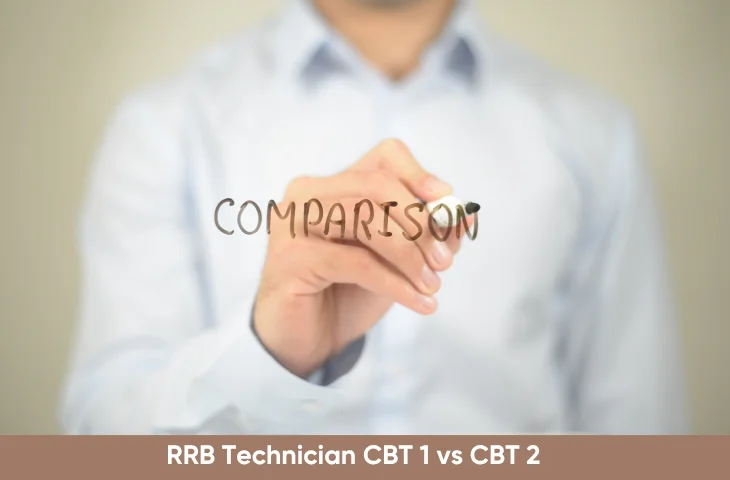RRB Technician CBT 1 vs CBT 2: If you’re preparing for the RRB Technician pipeline, understanding how CBT-1 and CBT-2 differ, both in syllabus and in the way you should prepare can save weeks of inefficient study. This article breaks down the two stages, compares their syllabi side by side, and provides practical, actionable strategies you can start using right away.
RRB Technician CBT 1 and CBT 2 Difference
There are certain differences noticed if we compare RRB Technician CBT 1 vs CBT 2. Check out the details given below:
| Feature | CBT 1 | CBT 2 |
| Purpose | Screening test to shortlist candidates | Detailed exam for trade-specific evaluation |
| Nature | Objective, general topics | Domain-specific, applied, and technical knowledge |
| Subjects Covered | General Awareness, Arithmetic, General Science, General Intelligence & Reasoning, Basics of Computers | Electrical, Mechanical, Electronics, or other trade applied for |
| Difficulty Level | Moderate — focuses on basics and speed | Higher — focuses on accuracy, depth, and applied concepts |
| Exam Approach | Speed matters (tight time per question) | Accuracy and deeper understanding matter more than raw speed |
| Goal | Shortlist candidates for the next stage | Test professional/technical competency for final selection |
RRB Technician CBT 1 and CBT 2 Syllabus
The RRB Technician Syllabus for CBT 1 and 2 is given below in the table for the exam aspirants. It is important to cover all the important topics to qualify for the exam on the first attempt:
| Component | CBT-1 (Screening) | CBT-2 (Trade / Post-specific) |
| Purpose | Shortlisting large candidate pool | Final merit based on trade competence |
| Question type | Objective, multiple choice | Objective (MCQs) — technically deeper |
| Topics (core) | General Awareness, General Science, Arithmetic, Reasoning, Computers | Trade-specific engineering topics (Electrical / Mechanical / Electronics / IT / Instrumentation / Civil), plus some general topics depending on post |
| Difficulty | Easy → Moderate | Moderate → High |
| Number of questions | Fixed (e.g., 100) — varies by notification | Fewer or similar count but focused on trade |
| Negative marking | Usually yes (penalty for wrong) | Usually yes (varies) |
| Time pressure | High (speed & accuracy) | Moderate (conceptual understanding required) |
RRB Technician CBT 1 vs CBT 2 Syllabus Breakdown
We have provided a table showing the detailed RRB Technician CBT 1 vs CBT 2 syllabus breakdown. Check out the details below:
| Stage | Focus Area | Detailed Topics |
| CBT-1 | Arithmetic (Quant) | Percentages, Ratio & Proportion, Time & Work, SI/CI, Profit & Loss, Average, Time & Distance, Mensuration basics |
| General Intelligence & Reasoning | Series, Analogy, Coding-Decoding, Syllogism, Blood Relations, Directions, Basic Puzzles | |
| General Awareness & Science | Static GK, Current Affairs (last 6–12 months), Basic Physics, Chemistry, Biology (everyday applications) | |
| Basic Computers | Fundamentals (hardware/software), Operating Systems, Networking basics, MS Office concepts | |
| CBT-2 | Electrical | Circuit Theory, Transformers, Motors, Power Systems, Measurement & Instrumentation, Electrical Machines, Protective Devices |
| Mechanical | Thermodynamics, Strength of Materials, IC Engines, Manufacturing Processes, Machine Design basics, Fluid Mechanics | |
| Electronics/Instrumentation | Analog & Digital Electronics, Microprocessors, Sensors, Control Systems, Signal Processing basics | |
| Civil / IT / Other Trades | Core diploma/engineering-level subjects relevant to the applied trade |
RRB Technician Strategy for CBT 1 and 2
Candidates must develop proper preparation strategies for both CBT 1 and 2 exams. Some of them are given below:
| Stage | Strategy | Key Actions | Example |
| CBT-1 | Win with Speed + Accuracy | – Focus on 10–12 high-yield topics in Arithmetic & Reasoning (foundation, not depth) – Do timed sectional tests (20–25 Qs in 15 min) – Keep a daily GK routine (15–20 min current affairs + static railway GK + science basics) – Maintain an error log for repeated mistakes – Attempt weekly full-length mocks; analyze weak areas & time leaks | Daily Micro-Plan • 60 min Quant drills (rotating topics) • 40 min Reasoning puzzles + 20 min error review • 20 min Current Affairs + 15 min Computer basics |
| CBT-2 | Master the Trade | – Do syllabus mapping (categorize into must-know, should-know, nice-to-know) – Build conceptual clarity (solve application-based problems, explain concepts simply) – Practice past papers & trade MCQs – Prepare a formula & diagram bank (circuits, processes, formulas) – Attempt 6+ full technical mocks in simulated exam conditions | Weekly Plan • 3 study blocks (90–120 min each) on core trade topics • 1 practice test + 1 formula/diagram revision session • 1 full-length mock exam |
RRB Technician CBT 1 and CBT 2 Exam Pattern
The RRB Technician Exam Pattern for CBT 1 and 2 varies in certain aspects. Given below are the details:
| Feature | CBT 1 | CBT 2 |
| Purpose | Screening test to shortlist candidates | Trade/post-specific merit ranking |
| Number of Questions | ~100 | ~100 (may vary by trade) |
| Total Marks | 100 | 100 |
| Duration | 90 minutes (for general candidates) | 90–120 minutes (depending on post/trade) |
| Question Type | Objective, Multiple Choice Questions (MCQs) | Objective, MCQs (technically deeper) |
| Syllabus | General Awareness, Arithmetic, General Science, General Intelligence & Reasoning, Basic Computer Knowledge | Trade-specific engineering topics + some general knowledge depending on post |
| Difficulty Level | Easy to Moderate | Moderate to High |
| Negative Marking | Yes, 1/3rd of the marks deducted for wrong answers | Yes, 1/3rd of the marks deducted for wrong answers |
| Focus | Speed, accuracy, and basic knowledge | Conceptual clarity, trade knowledge, and problem-solving |
| Time Pressure | High (less time per question) | Moderate (conceptual questions may take longer) |
Practical Study Tools & Resources for RRB Technician Exam
The RRB Technician Exam Date 2025 is expected to be released soon for the candidates. Applicants must start their preparation to secure the qualifying marks. Some of the practical study tools and resources for the upcoming exam are given below:
- Books: Diploma/degree-level textbooks for your trade; RRB-specific guidebooks for quick revision.
- Online: Topic-wise video lectures for tricky concepts, question banks with explanations.
- Apps: Daily current affairs apps (use 10–15 min/day), mock test apps for timed practice.
- Peer study: Small group sessions to discuss tricky trade problems and solve puzzles.
Common Mistakes to Avoid
There are certain mistakes that every exam applicant must try to avoid. Given below are the details:
- Studying trade theory for CBT-1 instead of basics — wastes time.
- Ignoring negative marking; random guessing can hurt rank.
- Not analyzing mock tests — repeating same errors.
- Overloading on low-yield current affairs; focus on railways & national events.
- Neglecting sleep and timetable adherence — consistency beats cramming.
Summary
To sum up everything, we have provided the important points below. Candidates can check them for a quick overview:
- CBT-1 is a speed & breadth test: shortlist candidates using general topics and basic technical awareness. Quick practice, high accuracy, and regular mocks are essential.
- CBT-2 is a depth & trade-competence test: requires conceptual clarity, problem-solving, and application of engineering principles. Build a trade checklist and prioritize “must-know” topics.
- Time your preparation: use the first phase to clear CBT-1 with confidence, then pivot to intense trade preparation for CBT-2. Maintain an error log, take regular mocks, and revise formulas/diagrams weekly.
Treat RRB Technician CBT-1 vs CBT-2 as two distinct battles in the same war. CBT-1 filters by speed and general competency, prepare to be fast and consistent. CBT-2 rewards depth and applied knowledge, prepare to be accurate, methodical, and technically confident. With a structured plan, targeted resources, and disciplined mock practice, you can clear both stages and secure a high rank. Ready to convert the plan into a 60-day study calendar? I can draft one tailored to your trade and available hours.
FAQs
CBT-1 is a screening test focused on general awareness, arithmetic, reasoning, basic science, and computer knowledge. CBT-2 is trade-specific and tests in-depth technical knowledge related to the applied post. CBT-1 evaluates speed and accuracy, while CBT-2 evaluates conceptual understanding and application.
For CBT-1, focus on speed, high-yield topics, and mock tests covering arithmetic, reasoning, and general science. For CBT-2, focus on trade-specific topics, conceptual clarity, formulae, diagrams, and solving previous years’ trade MCQs.
Yes, most RRB Technician exams include negative marking in both CBT-1 and CBT-2. Usually, 1/3rd of the marks for a wrong answer are deducted. It is essential to attempt questions carefully and avoid random guessing.
Partially. General awareness, reasoning, and arithmetic material can be used for CBT-1. However, for CBT-2, you need specialised books, diploma/engineering-level textbooks, and trade-specific guides.
Mock tests are crucial for both CBT-1 and CBT-2. For CBT-1, they improve speed and accuracy under time constraints. For CBT-2, they help in applying technical knowledge, identifying weak areas, and getting familiar with trade-specific question patterns.

Hello! This is Arijit Dutta. I am a skilled Content Writer at Oliveboard with nearly 3+ years of experience in crafting engaging, informative, and exam-focused content for the Railways Domain. With a strong command of language and a keen understanding of learner needs, I contribute significantly to Oliveboard’s mission of delivering high-quality educational resources. Passionate about clear communication and continuous learning, I consistently create content that helps government job aspirants achieve their goals. Outside of work, I enjoy playing cricket and listening to music, which helps me stay balanced and creative in my professional journey.
